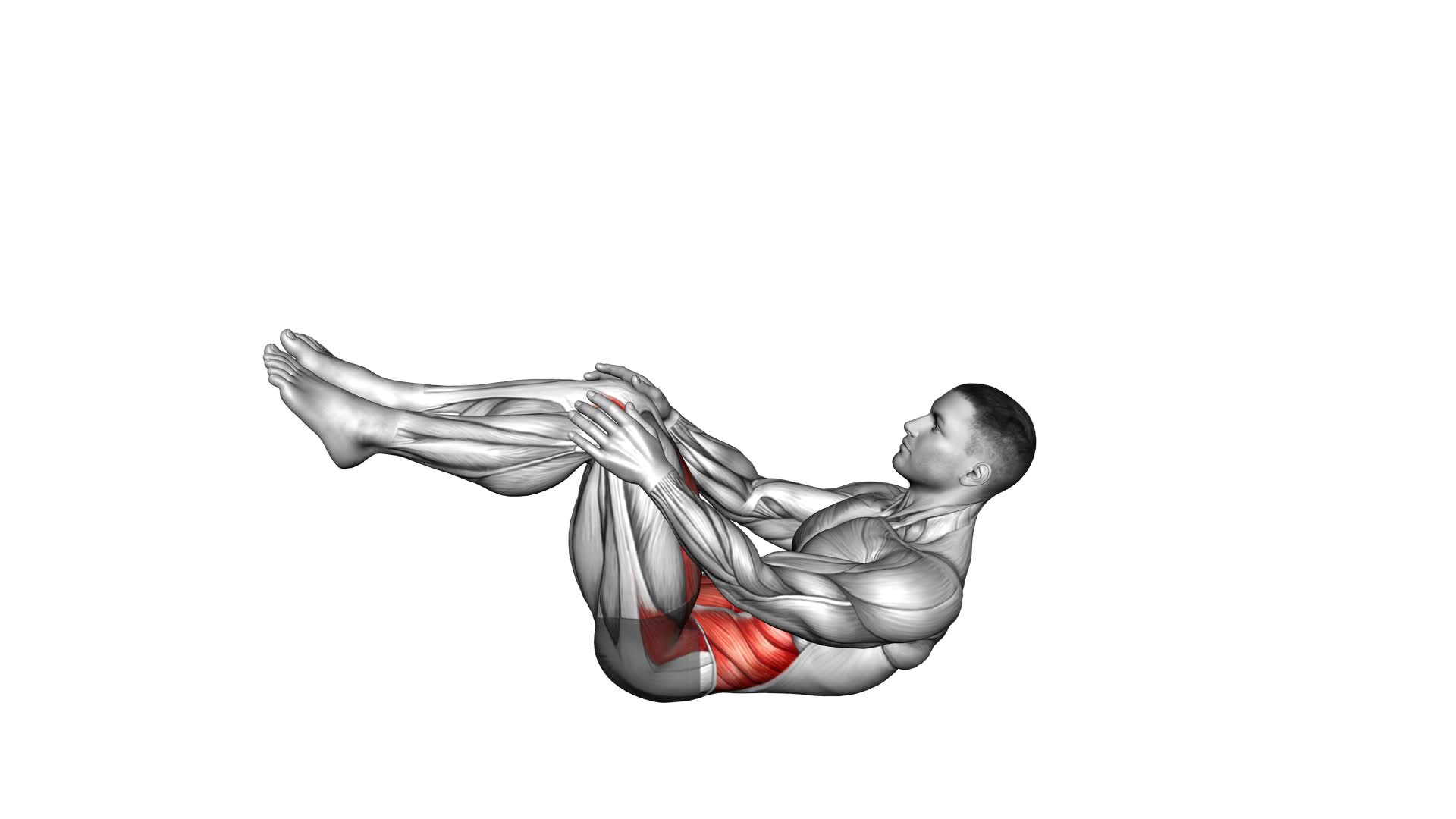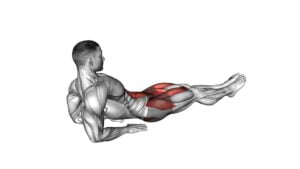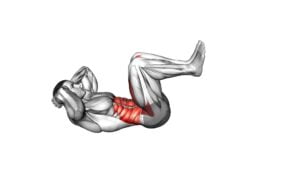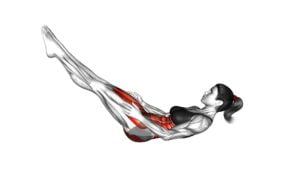Lying Tuck-up Knee Tap (male) – Video Exercise Guide & Tips

Looking to strengthen your core and improve your lower body strength? The Lying Tuck-up Knee Tap is the perfect exercise for you.
Watch This Exercise Video
In this video exercise guide, we'll show you the proper form and technique to maximize results. Whether you're a beginner or advanced, we've got modifications for every level.
Avoid common mistakes and get ready to feel the burn.
Let's dive in and take your fitness to the next level.
Key Takeaways
- The lying tuck-up knee tap activates abdominal muscles and strengthens the rectus abdominis.
- It engages hip flexors, obliques, and lower back muscles, improving core stability and balance.
- Proper form and technique are important, including aligning knees with hips and ankles and avoiding arching the back or using momentum.
- Modifications for beginners and advanced levels can be made to increase or simplify the intensity of the exercise.
Benefits of the Lying Tuck-up Knee Tap
You can experience significant abdominal muscle activation by performing the Lying Tuck-up Knee Tap exercise. This exercise offers a wide range of benefits that can enhance your overall fitness routine.
Firstly, the Lying Tuck-up Knee Tap targets your rectus abdominis, commonly known as the six-pack muscles, helping to strengthen and tone them. Additionally, this exercise engages your hip flexors, obliques, and lower back muscles, providing a comprehensive core workout.
By consistently incorporating the Lying Tuck-up Knee Tap into your routine, you can improve your core stability and balance, which is essential for performing daily activities and sports. Moreover, this exercise can also contribute to better posture by strengthening the muscles that support your spine.
The Lying Tuck-up Knee Tap is a versatile exercise that can be modified to suit different fitness levels and goals. Whether you're a beginner or an experienced athlete, this exercise can be tailored to meet your specific needs.
Proper Form and Technique for the Exercise
To perform the lying tuck-up knee tap exercise with proper form and technique, there are a few key points to keep in mind.
First, engaging your core is crucial to maintain stability throughout the movement.
Secondly, ensure that your knees are properly aligned with your hips and ankles to avoid any strain or injury.
Lastly, be mindful of common mistakes such as using momentum instead of controlled movements and arching your back.
Core Engagement Importance
Proper core engagement is crucial for performing the lying tuck-up knee tap exercise effectively and safely.
The importance of core stability can't be overstated when it comes to maintaining proper form and technique during this exercise. Your core muscles, including the abdominals, obliques, and lower back, play a key role in stabilizing your spine and pelvis, allowing for controlled movement and reducing the risk of injury.
Core strengthening exercises, such as the lying tuck-up knee tap, target these muscles and help improve overall core stability. By engaging your core throughout the exercise, you can maximize the benefits and ensure that your body is properly supported.
Now, let's move on to discussing some important knee alignment tips to further enhance your performance and safety.
Knee Alignment Tips
Maintaining proper knee alignment is essential for performing the lying tuck-up knee tap exercise effectively and safely, as it builds upon the foundation of core engagement.
To ensure correct knee alignment during this exercise, there are a few key tips to keep in mind.
First, focus on keeping your knees in line with your toes throughout the movement. This helps to distribute the load evenly and prevents unnecessary strain on the knee joints.
Second, engage your hip muscles to stabilize the knees. Strong hip muscles provide support and help maintain proper alignment.
Lastly, avoid any excessive inward or outward movement of the knees, as this can put undue stress on the joint.
Incorporating these knee alignment exercises and knee stability techniques will help you perform the lying tuck-up knee tap exercise with proper form and technique, reducing the risk of injury.
Common Mistakes to Avoid
One common mistake to avoid when performing the lying tuck-up knee tap exercise is allowing your knees to collapse inward. Maintaining proper form and technique is essential for maximizing the effectiveness of this exercise and preventing injury. When performing the knee tap, ensure that your knees are aligned with your toes, pointing straight ahead. Avoid letting your knees cave in or move outward during the movement.
Instead, focus on engaging your core muscles and using them to control the movement of your legs. Another common mistake is lifting your head and shoulders off the ground, straining your neck. Keep your head and shoulders relaxed and maintain a neutral spine throughout the exercise.
Modifications for Beginners and Advanced Levels
Let's talk about some modifications you can make to the lying tuck-up knee tap exercise to accommodate different fitness levels.
For beginners, simplifying the movements by reducing the range of motion or providing additional support can help make the exercise more manageable.
On the other hand, advanced modifications involve increasing the intensity by adding resistance or incorporating variations that challenge your stability and strength.
It's also important to consider level progression strategies, gradually increasing the difficulty of the exercise as you become more comfortable and proficient.
Beginner Modifications: Simplify Movements
To simplify movements for beginners and advanced levels, you can start with using a modified approach. When it comes to the lying tuck-up knee tap exercise, there are simplified variations that can be done to make it more accessible for beginners.
Instead of performing the full movement, beginners can start by doing a modified version where they bring their knees towards their chest without tapping the knees. This reduces the difficulty and allows beginners to focus on proper form and technique.
As they progress and feel more comfortable, they can gradually add in the knee tap component. This gradual progression helps to build strength and coordination, making the exercise more challenging over time.
Advanced Modifications: Increase Intensity
To increase the intensity of the lying tuck-up knee tap exercise for both beginners and advanced levels, you can incorporate additional challenging variations into your routine. Here are three advanced variations that will help you increase the difficulty of this exercise:
- Double Knee Tap: Instead of tapping one knee at a time, try tapping both knees together. This will engage your core and lower body even more.
- Weighted Knee Tap: Hold a dumbbell or kettlebell in your hands while performing the knee tap. This added resistance will challenge your muscles and make the exercise more intense.
- Extended Leg Tap: Instead of keeping your legs bent, straighten them out as you tap your knees. This will require more strength and stability, increasing the difficulty of the exercise.
Incorporating these advanced variations into your lying tuck-up knee tap routine will help you push your limits and continue making progress. Remember to listen to your body and only attempt these variations if you feel confident and ready.
Level Progression Strategies
To progress your level in the lying tuck-up knee tap exercise, implement modifications tailored to your skill level and goals. Progression techniques and exercise variations can be utilized to challenge yourself and continue improving.
For beginners, start with the basic lying tuck-up knee tap exercise. Once you feel comfortable and confident, you can progress by increasing the number of repetitions or sets. You can also try performing the exercise at a slower pace to engage your muscles even more.
Advanced individuals can incorporate variations to further intensify the exercise. For example, you can add ankle weights or hold a dumbbell between your feet as you perform the tuck-up knee tap. Another option is to extend your legs fully during the tuck-up phase, increasing the difficulty and engaging your core muscles even more.
Remember to listen to your body and progress at a pace that's challenging but still safe. By implementing these progression strategies, you can continue to improve your strength and fitness level with the lying tuck-up knee tap exercise.
Common Mistakes to Avoid
Avoid these common mistakes when performing the Lying Tuck-up Knee Tap exercise:
- Rounding your lower back: One common mistake is rounding your lower back instead of keeping it flat against the ground. This not only reduces the effectiveness of the exercise but also puts unnecessary strain on your spine. Make sure to engage your core and maintain a neutral spine throughout the movement.
- Using momentum: Another mistake to avoid is using momentum to complete the exercise. It's important to perform the movement in a controlled manner, focusing on the contraction of your abs. Avoid swinging your legs or using momentum to lift your upper body off the ground.
- Neglecting modifications: If you find the Lying Tuck-up Knee Tap too challenging, don't be afraid to modify the exercise. You can start by bending your knees and tapping your heels on the ground instead of your knees. As you build strength, gradually progress to the full exercise.
Tips for Maximizing Results
Focus on proper breathing techniques to enhance the effectiveness of the Lying Tuck-up Knee Tap exercise. Maximizing results and improving performance can be achieved by following these tips:
- Maintain proper form: Keep your core engaged and your lower back pressed firmly against the floor throughout the exercise. This will help target the abdominal muscles effectively.
- Control your movements: Slowly lift your legs and tap your knees, focusing on the contraction of the abs. Avoid using momentum or swinging your legs, as it can reduce the effectiveness of the exercise.
- Breathe correctly: Inhale deeply through your nose as you lower your legs, and exhale through your mouth as you lift them. This will help engage the deep core muscles and stabilize your body.
- Increase intensity gradually: Start with a comfortable number of repetitions and gradually increase as you build strength and endurance. Push yourself, but listen to your body and avoid overexertion.
By incorporating these tips, you can maximize the results of the Lying Tuck-up Knee Tap exercise and improve your overall performance.
Now, let's move on to the next section, where we'll provide a sample workout routine that incorporates the lying tuck-up knee tap.
Sample Workout Routine Incorporating the Lying Tuck-Up Knee Tap
To optimize your results and enhance your performance with the Lying Tuck-Up Knee Tap exercise, it's important to follow a sample workout routine that incorporates this challenging movement. By incorporating the Lying Tuck-Up Knee Tap into your routine, you can effectively strengthen your core and improve your overall fitness.
Here is a sample workout routine that includes this exercise:
- Warm-up: Begin your workout with a 5-minute cardio warm-up to get your blood flowing and prepare your muscles for the workout ahead.
- Lying Tuck-Up Knee Tap: Start by lying flat on your back with your arms extended overhead. Lift your legs off the ground, tuck your knees towards your chest, and tap your knees with your hands. Repeat this movement for 10-12 reps.
- Circuit Training: Incorporate the Lying Tuck-Up Knee Tap into a circuit training routine by alternating it with other core strengthening exercises such as planks, Russian twists, and bicycle crunches. Perform each exercise for 30 seconds to 1 minute before moving on to the next one. Repeat the circuit 2-3 times.
- Cool-down: Finish your workout with a 5-minute cool-down consisting of stretches for your core, such as the cat-camel stretch and the child's pose, to help your muscles recover.
Frequently Asked Questions
How Many Calories Does the Lying Tuck-Up Knee Tap Exercise Burn?
The lying tuck-up knee tap exercise can help you burn calories and increase exercise intensity.
By engaging your core muscles and performing the movement with control and precision, you can elevate your heart rate and stimulate calorie burn.
The exact number of calories burned during this exercise may vary depending on factors such as your weight, intensity, and duration.
However, incorporating this exercise into your routine can contribute to your overall calorie-burning goals.
Can I Perform the Lying Tuck-Up Knee Tap Exercise if I Have Lower Back Pain?
If you have lower back pain, it's important to consider modifications for the lying tuck-up knee tap exercise. This exercise can put strain on your lower back, so it might be best to avoid it until your pain subsides.
Instead, focus on stretching exercises that target the lower back to help alleviate pain and improve flexibility. Consult with a professional to find the best exercises for your specific condition.
How Often Should I Incorporate the Lying Tuck-Up Knee Tap Exercise Into My Workout Routine?
To incorporate the lying tuck-up knee tap exercise into your workout routine, start by learning how to properly perform it.
This exercise targets your abdominal muscles and improves core strength. It involves lying on your back, lifting your legs and upper body off the ground, and tapping your knees with your hands.
Can the Lying Tuck-Up Knee Tap Exercise Help Improve My Flexibility?
The lying tuck-up knee tap exercise can definitely help improve your flexibility. By engaging your core muscles and stretching your legs, this exercise targets multiple muscle groups, increasing your range of motion and overall flexibility.
The benefits of incorporating the lying tuck-up knee tap exercise into your workout routine include improved mobility, enhanced athletic performance, and reduced risk of injuries.
Are There Any Alternative Exercises That Target the Same Muscle Groups as the Lying Tuck-Up Knee Tap Exercise?
If you're looking for alternative exercises that target the same muscle groups as the lying tuck-up knee tap, there are a few options you can try.
One option is the hanging leg raise, which also works your abs and hip flexors.
Another option is the Russian twist, which targets your obliques and core.
Additionally, the reverse crunch is a great exercise for targeting your lower abs.
Incorporating these exercises into your routine can help you achieve a well-rounded workout.
Conclusion
The lying tuck-up knee tap is a challenging exercise that targets the core muscles and helps improve overall strength and stability.
By maintaining proper form and technique, beginners can gradually build up their strength while advanced individuals can push their limits.
Avoiding common mistakes and following helpful tips can maximize the effectiveness of this exercise.
Incorporating the lying tuck-up knee tap into a well-rounded workout routine can lead to great results in terms of core strength and overall fitness.

Author
Years ago, the spark of my life’s passion ignited in my mind the moment I stepped into the local gym for the first time. The inaugural bead of perspiration, the initial endeavor, the very first surge of endorphins, and a sense of pride that washed over me post-workout marked the beginning of my deep-seated interest in strength sports, fitness, and sports nutrition. This very curiosity blossomed rapidly into a profound fascination, propelling me to earn a Master’s degree in Physical Education from the Academy of Physical Education in Krakow, followed by a Sports Manager diploma from the Jagiellonian University. My journey of growth led me to gain more specialized qualifications, such as being a certified personal trainer with a focus on sports dietetics, a lifeguard, and an instructor for wellness and corrective gymnastics. Theoretical knowledge paired seamlessly with practical experience, reinforcing my belief that the transformation of individuals under my guidance was also a reflection of my personal growth. This belief holds true even today. Each day, I strive to push the boundaries and explore new realms. These realms gently elevate me to greater heights. The unique combination of passion for my field and the continuous quest for growth fuels my drive to break new ground.







